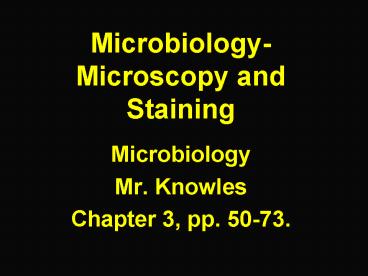Microbiology Microscopy and Staining PowerPoint PPT Presentation
1 / 42
Title: Microbiology Microscopy and Staining
1
Microbiology-Microscopy and Staining
- Microbiology
- Mr. Knowles
- Chapter 3, pp. 50-73.
2
What is the smallest object ever seen?
3
SPM of a Bacillus Bacterium
4
SPM of Coccus Bacterium
5
Carbon Atoms on Graphite
6
Neon Atoms on Nickel
7
What is light?
- Light is visible energy!
8
(No Transcript)
9
(No Transcript)
10
(No Transcript)
11
(No Transcript)
12
Can other animals see other parts of the EM
spectrum?
- An Application
- Video- Discovery Vipers (Pit Vipers)
13
Properties of Light
- Wavelength and Resolution
- Light and Objects
14
Wavelength (?)
15
(No Transcript)
16
(No Transcript)
17
(No Transcript)
18
(No Transcript)
19
How does wavelength compare to energy?
- An Application Video- The Blue Planet The Deep
20
Light and Wavelength
- Length of a light ray- wavelength.
- Usually represented by the Greek letter ?.
- Sun produces a continuous spectrum of EM
radiation. - Visible light is from about ? 420 nm (blue) to
680 nm (red). - Fig 3.4, p 54.
21
(No Transcript)
22
A. Resolution
- Resolution - the ability to see two objects as
separate and discrete. - A wavelength of light must be able to pass
between the objects for them to be seen as
separate. - Shorter the wavelength, the greater the
resolution.
23
Resolution
- Visible Light (? 550 nm) has a resolution of
about 220 nm. - UV (? 100-400 nm) has a resolution of about 110
nm. - Electron Microscopes use electrons rather than
light, e- ? 0.005 nm, resolution of EM is about
0.2 nm
24
B. Reflection
- Fig. 3.7, p. 56.
- Reflection- particular wavelengths strike an
object and bounce back - Reflected wavelengths give objects color.
25
(No Transcript)
26
C. Transmission
- Transmission- passage of light through an object.
- Opaque objects cannot transmit any light.
27
D. Absorption
- Absorption- when light rays do not pass through
nor do they bounce back, but are used when light
rays are neither transmitted nor reflected, they
are absorbed.
28
(No Transcript)
29
What happens to the energy of absorbed light?
- Energy from light rays can be used.
- Green leaf absorbs all wavelengths (except green)
for use in photosynthesis. - Energy from absorbed light is transformed into
heat. - Ex. Black car on a hot day.
30
What happens to the energy of absorbed light?
- Absorbed light rays are changed into longer
wavelengths and reemitted- luminescence - Bacteria and other organisms can bioluminesce
31
Two Types of 1. Luminescence
- a. If luminescence occurs after an object has
been exposed to light - phosphorescence.
32
Deep Sea Angler Fish
33
Phosphorescent Bacteria in Lanternfish
34
Show me Phosphorescence!
- Vibrio fischeri- a phosphorescent bacterium
35
Two types of 1. Luminescence
- b. If luminescence occurs only while light rays
are striking an object - fluorescence.
36
Fluorescent Methanosarcina Bacterium
37
Use of Fluorescent Antibodies to Stain Cells
(Bovine Pulmonary Arterial Endothelial Cell)
38
Show me Fluorescence!
- Pseudomonas fluorescens- a fluorescent bacterium
39
(No Transcript)
40
An Application of Refraction
- Video Built for the Kill- River
41
E. Refraction
- Refraction- bending of light as it passes from
one medium to another of a different density. - Index of Refraction- a measure of the speed at
which light passes through a material.
42
A Magic Trick!
- Using the physics of light to make money!

